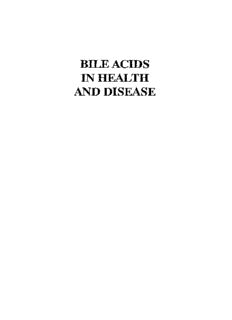
Bile Acids in Health and Disease: Update on Cholesterol Gallstones and Bile Acid Diarrhoea PDF
Preview Bile Acids in Health and Disease: Update on Cholesterol Gallstones and Bile Acid Diarrhoea
BILE ACIDS IN HEALTH AND DISEASE BILE ACIDS IN HEALTH AND DISEASE Update on Cholesterol Gallstones and Bile Acid Diarrhoea Editors Tim Northfield, Riadh Jazrawi and Patrick Zentler-Munro Department ofMedicine, St. GeorgesHospital Medical School London, UK KLUWER ACADEMIC PUBLISHERS DORDRECHT/BOSTON/LONDON Distributors fortheUnitedStatesandCanada:KluwerAcademicPublishers,POBox358,AccordStation, Hingham,MA02018-0358,USA forallothercountries:KluwerAcademicPublishersGroup,DistributionCenter,POBox322, 3300AHDordrecht,TheNetherlands BritishLibraryCataloguinginPublicationData Bileacidsinhealthanddisease. 1. Man. Bileacids I. Northfield,Tim II.Jazrawi,Riadh III. Zentler-Munro,Patrick 612'.35 ISBN-13:978-94-010-7054-6 e-ISBN-13:978-94-009-1249-6 DOl: 10.1007/978-94-009-1249-6 Copyright © 1988byKluwerAcademicPublishers Softcoverreprintofthehardcover Istedition 1988 Allrightsreserved.Nopartofthispublicationmaybereproduced,storedinaretrievalsystem, ortransmittedinanyformorbyanymeans,electronic,mechanical,photocopying,recording orotherwise,withoutpriorpermissionfromthepublishers,KluwerAcademicPublishersBV, POBox17,3300AADordrecht,TheNetherlands. PublishedintheUnitedKingdombyKluwerAcademicPublishers, POBox55,Lancaster,UK KluwerAcademicPublishersBVincorporatesthepublishingprogrammesof D.Reidel,MartinusNijhoff,DrW.JunkandMTPPress Contents Preface YIn Listofinvitedspeakers x 1 Overview: the enterohepaticcirculationofbileacids-a topic inmolecularphysiology A.F.Hofmann 1 SECTIONA BILIARYCHEMISTRYANDPHYSIOLOGY 2 Hepaticbile acid transportandsecretion S. Erlinger 21 3 Hepaticbiliarylipidsynthesisand transport 1. Graham, H.Ahmedand T.e. N01thfield 27 4 Biliarylipidsecretionand itscontrol R. Coleman, K Rahman, M.E. Bel/ringerandM. Carrel/a 43 5 Lipidsolubilisationinbile M.e. Carey 61 6 Gallbladdermotorfunction A. LanziniandT.e. Northfield 83 SECTIONB PATHOGENESISOFCHOLESTEROL GALLSTONEDISEASE 7 Thesecretorydefect K EinarssonandB.Angelin 99 8 Thephysico-chemical defect R.T. Holzbach, R.L. BarnhartandI.M. Nader 117 9 The motilitydefect I.e. Forgacs 135 v BILEACIDSINHEALTHANDDISEASE SECTIONC GALLSTONEPREVENTION 10 Cluesfromepidemiology K. Heaton 157 11 Post-dissolutiontrials K.A. Hood 171 SECTIOND NON-SURGICALTREATMENTOFGALLSTONES 12 Cheno-versusursodeoxycholicacid L. Barbara, F. BazzoUandE. Roda 183 13 Cheno-plusursodeoxycholicacid M. Podda, M. ZuinandP.M. Battezzati 187 14 Methyl tert-butylether J.L. Thistle 195 15 Lithotripsy G. Paumgartner, M. Sackman, J. Holland T. Sauerbruch 201 16 Overallstrategy T.e. NorthfieldandR.P.Jazrawi 205 SECTIONE LIPIDDIGESTIONANDBILEACID ABSORPTION 17 Fatdigestionandsolubilisation B. Borgstrom 217 18 Bileacidabsorption A. Stiehl 229 SECTIONF LIPIDMALDIGESTIONANDBILEACID MAlABSORPTION 19 Fatdigestionandsolubilisationindisease P.L. ZentIer-Munro, D. FineandT.e. Northfield 239 20 Bileacid malabsorption,diarrhoeaandsteatorrhoea H.V.Ammon 253 21 Bileacids inirritablebowelsyndrome M. EastwoodandM. Merrick 267 vi CONrENTS SECTIONG DIAGNOSISOFBILEACIDMAlABSORPTION- ROLE 7S OF SeHCAT 22 75SeHCAT: anoverviewofitsphysiologicalpropertiesand clinicalvalue R.P.Jazrawi, R. Fe"arisandT.e. Northfield 277 23 Wholebodyand abdominal retentionof75SeHCAT G. Sci~etta, G. Faglioli,A.Furno, G. ViciniandP. Malaguti 291 24 Gallbladderretentionof75SeHCAT R. Fe"aris 301 Index 307 vii Preface Bileacidsoccupyacentralpositioninintheabsorption,excretionandmetab olismoflipidswithinthebody.Ourunderstandingoftheiruniqueproperties hasilluminated manybiochemicalandbiophysicalprocesses. Animals have evolved a unique system of preserving these important detergent-like moleculeswithinthebodyand reusingthemmanytimes- theenterohepatic circulation. Disorders ofthe enterohepatic circulation contribute to a correspondingly wide range ofdiseases, and recentdevelopments have centred inparticular oncholesterolgallstonediseaseandbileaciddiarrhoea.Successfulmanage ment of these diseases is increasingly based on an understanding of the physicochemical and biochemical properties of bile acids, and of their pathophysiological role indisease. Professor Alan Hofmann starts this book with an overview of the enterohepaticcirculationofbileacids.Thefirstsectionthendiscussesbiliary lipidsynthesis, transport and secretionby the liverand the solubilisation of cholesterol in the bile. The next section applies this knowledge to the pathogenesisofcholesterolgallstones.Separatechaptersfocusondefectsin biliary lipid secretion, in cholesterol solubilisation and in gallbladder motility. The succeeding sections then review posssible approaches to gallstoneprevention, and assess recentdevelopments in non-surgicalforms oftreatment.Twoexcitingnewtherapiesthatreceiveparticularattentionare contact dissolution therapywith methyl tert-butyl ether and extracorporeal shockwave lithotripsy. Further sections turn to the absorptive functions of bile acids in health. These relate to the absorption offat and electrolytes, and to the subsequent reabsorptionofthe bile acids themselves.Therefol lowsadiscussionofthecontributionofbileacidstothepathogenesisofdiar rhoea and steatorrhoea.The most noteworthy clinical advance has been in the diagnosis of bile acid malabsorption and bile acid diarrhoea using the gammaemitting75SeradiolabelledbileacidSeHCAT,whichhasprovideda diagnostic tool available for the first time in any hospital with a gamma camera. This book is addressed primarily to gastrointestinal physicians and physiologists. However, anyonewhoshares ourinterestinthesefascinating moleculeswillgleannewinsightsfomthiscompendium.Theinvitedauthors Vlll BILEACIDSINHEALTIIANDDISEASE are drawnfrom those international centreswhich have contributed most to ourunderstanding.Theircontributions have beenheavilyedited to achieve acohesivevolumeofuniformstyleandformat.Aseditors,weacceptrespon sibilityfor anydeficienciesin thefinal result. DepartmentofMedicine TimNorthfield St. George'sHospitalMedicalSchool RiadhJazrawi London PatrickZentler-Munro Acknowledgements The preparation ofthis bookwas stimulated by the enthusiasm ofthe con tributorsatameetingentitled"BileAcidsinHealthandDisease"heldatthe Royal Society ofMedicine, London in September, 1987. This meetingwas generouslysponsoredbyDr.HerbertFalkthroughtheFalkFoundation,and byhis UKcollaborators,ThamesLaboratories.Wewouldalsoliketo thank MissMarionAmosand Mr. MartinListerfortheirvaluableassistanceinthe productionofthebook. IX List ofInvited Contributors ProfessorHelmutAmmon, HenryFordHospital, Detroit,USA ProfessorLuigiBarbara, Universitadi Bologna,Italy ProfessorBengtBorgstrom, UniversityofLund, Sweden ProfessorMartinCarey,Harvard Medical School,Boston, USA Dr.RogerColeman, UniversityofBirmingham, UK Dr. MartinEastwood, WesternGeneralHospital, Edinburgh, UK Dr.Kurt Einarsson,Huddinge UniversityHospital, Sweden ProfessorSergeErlinger,HopitalBeaujon,Clichy,France Dr.Roberto Ferraris, Ospedale Mauriziano,Turin, Italy Dr.IanForgacs,King's CollegeHospital,London, UK Dr.JohnGraham, S1. George'sHospital MedicalSchool, London, UK Dr.KenHeaton, BristolRoyal Infirmary, UK ProfessorAlan Hofmann, UniversityofCalifornia,SanDiego,USA Dr.ThomasHolzbach,Cleveland Clinic, USA Dr.KathrynHood,Guy's HospitalMedical School,London, UK Dr.RiadhJazrawi, St.George'sHospital MedicalSchool,London, UK Dr.AlbertoLanzini, Ospedale Civili, Brescia,Italy Dr. PatrickZentler-Munro,Raigmore Hospital,UK Dr.TimNorthfield, S1. George'sHospital MedicalSchool, London, UK ProfessorGustavPaumgartner,KlinikumGrosshadern, Munich,FRG ProfessorMauroPodda, Istitutodi MedicinaInterna, Milan,Italy Dr.GiuseppeSciarretta, OspedaleMaggiore,Bologna,Italy ProfessorAdolfSteihl,UniversityofHeidelberg,FRG ProfessorJohnThistle, Mayo Medical School, USA x 1 Overview: Enterohepatic Circulation ofBile Acids - a Topic in Molecular Physiology A.F. Hofmann DivisionofGastroenterology, UniversityofCalifornia, San Diego LaJolla, California 92093, USA INTRODUCTION In principle, the scope of physiology should begin where cell biology ends. Physiology deals with the orchestrationoffunctions ofmultiple cells in dif ferentorgans,theendresultsofwhichareco-ordinatedphysiologicalproces sessuch as digestion and absorption orglucose homoeostasis. A triumphof cell biology has been the elucidation ofcellular regulatory circuits, and the limitingcaseisthatinwhichcellsregulatetheirownactivitiessoreliablythat there is no needfor regulatorycircuitsinvolvingmanyorgans. Ina sense, by analogy, thegovernanceofauniversityfacultyusuallyuses atinyproportion oftotal energy expenditure at the university because most facilities govern themselveseffectively, at least mostofthe time. For the enterohepatic circulation of bile acids, the major regulatory circuits are at a molecular and cell biological level, rather than at a higher level of integration. The one obvious exception to this generalisation is gastrointestinal motility, which is co-ordinated both enterally and centrally. Inthis briefessay, Iwish tosummarisemyownviews ofthefour subcircula tions of bile acids encompassed in the inclusive term 'enterohepatic circulation'.Itis probably useful to include the cholehepaticor biliohepatic circulation within the term enterohepatic, since the Greek word 'entero' is not very specific and could well include the biliary tract. Indeed, the tradi tion has beenfor gastroenterology to include considerations ofhepatic and biliaryfunction, physiology,andpathology,sothisviewhasampleprecedent. In this article, four subcirculations of the enterohepatic circulation willbedistinguished- bytheir location, mechanismoftransport,and conse quenceoftransport.Sincetheseenterohepaticcirculationsinvolvemanyor gans, the appropriate discipline is physiology. Yet any consideration ofthe
Description: